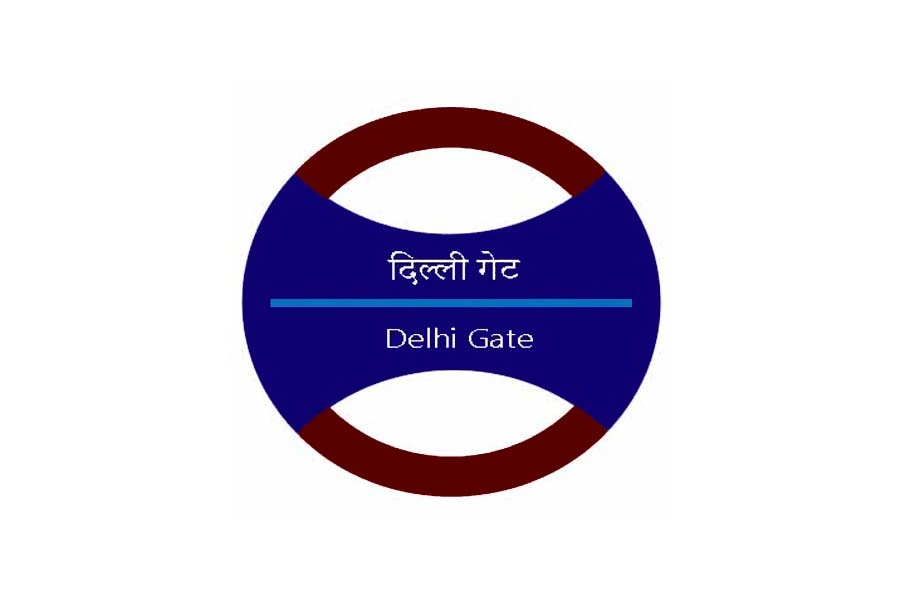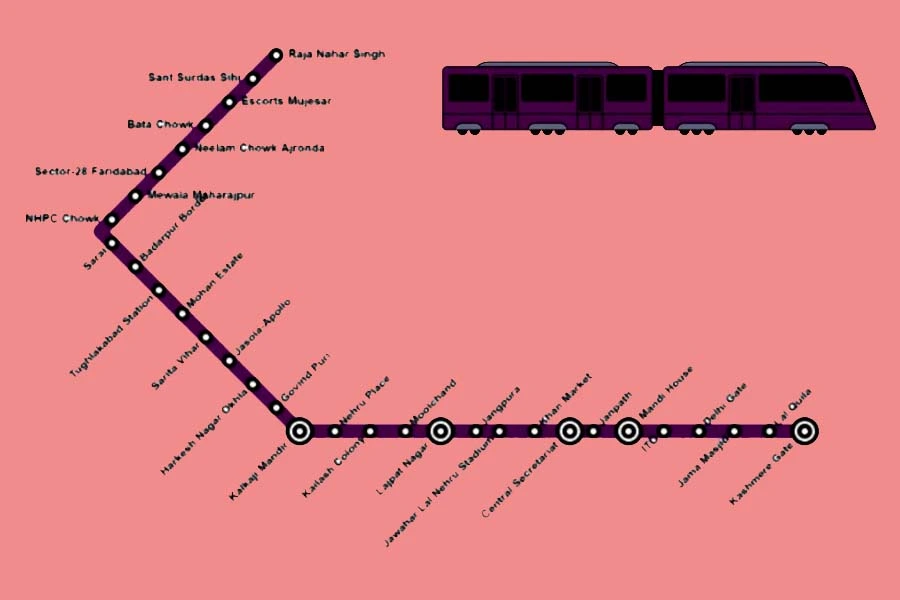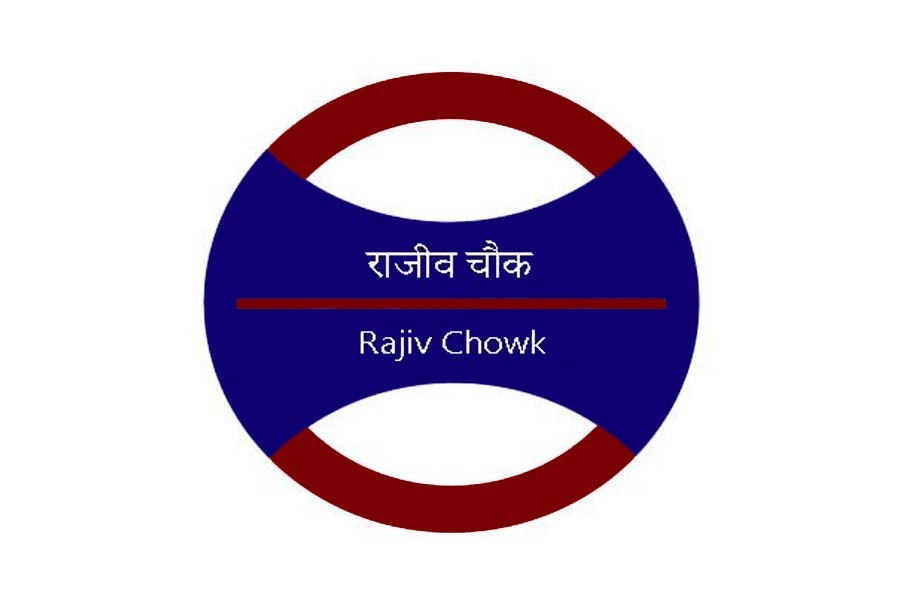Delhi Gate Metro Station(DMRC), Underground Violet Line station near Delhi Gate arch. Timings ~5:30 AM–11:15 PM. Connects Kashmere Gate↔Raja Nahar Singh. Fare ₹10–60.

Delhi Gate Metro Station is a significant stop on the Violet Line of the Delhi Metro network. Located on Asaf Ali Road, this station connects the historical heart of Delhi with the modern metro system. It is named after the iconic Delhi Gate, one of the original entrances to the walled city of Shahjahanabad, built by Mughal Emperor Shah Jahan in the 17th century. Today, the metro station acts as a bridge between heritage and progress, linking commuters to some of the most important landmarks in the capital.
The station is well-equipped with essential facilities such as escalators, elevators, clean restrooms, ticket counters, and digital displays. It features multiple entry and exit gates, each connecting to important nearby areas like Daryaganj, Ambedkar Stadium, and LNJP Hospital. It is also well-integrated with public transportation, including DTC buses, auto-rickshaws, and e-rickshaws, offering seamless travel to surrounding neighborhoods.
Delhi Gate Metro Station is also known for its cleanliness, safety measures, and accessibility features for differently-abled passengers. Its location provides convenient access to several historical attractions such as the Red Fort, Jama Masjid, and Raj Ghat. Furthermore, it supports nearby residential and commercial zones by offering easy connectivity to key parts of Delhi, including Connaught Place and Central Secretariat.
Whether you’re commuting for work, exploring Old Delhi, or traveling to major city points, Delhi Gate Metro Station offers a reliable, comfortable, and efficient travel experience for all.
Table of Contents
ToggleDelhi Metro Violet Line Route
| Station Name | Line | Approx. Distance (km) | Est. Travel Time (min) | Fare (INR) |
| Kashmere Gate | Violet Line | 1.5 | 3 | ₹10 |
| Lal Quila | Violet Line | 0.8 | 2 | ₹10 |
| Jama Masjid | Violet Line | 1.5 | 24 | ₹10 |
| Delhi Gate | Violet Line | 0 | 0 | 0 |
| ITO | Violet Line | 2.5 | 6 | ₹20 |
| Mandi House | Violet Line | 3.5 | 8 | ₹20 |
| Janpath | Violet Line | 4.5 | 10 | ₹20 |
| Central Secretariat | Violet Line | 5.5 | 12 | ₹30 |
| Khan Market | Violet Line | 6.5 | 14 | ₹30 |
| Jawaharlal Nehru Stadium | Violet Line | 7.5 | 16 | ₹30 |
| Jangpura | Violet Line | 8.5 | 18 | ₹30 |
| Lajpat Nagar | Violet Line | 9.5 | 20 | ₹30 |
| Moolchand | Violet Line | 10.5 | 22 | ₹30 |
| Kailash Colony | Violet Line | 11.5 | 24 | ₹30 |
| Nehru Place | Violet Line | 12.5 | 26 | ₹30 |
| Kalkaji Mandir | Violet Line | 13.5 | 28 | ₹30 |
| Govind Puri | Violet Line | 14.5 | 30 | ₹40 |
| Harkesh Nagar Okhla | Violet Line | 15.5 | 32 | ₹40 |
| Jasola Apollo | Violet Line | 16.5 | 34 | ₹40 |
| Sarita Vihar | Violet Line | 17.5 | 36 | ₹40 |
| Mohan Estate | Violet Line | 18.5 | 38 | ₹40 |
| Tughlakabad | Violet Line | 19.5 | 40 | ₹40 |
| Badarpur Border | Violet Line | 20.5 | 42 | ₹40 |
| Sarai | Violet Line | 21.5 | 44 | ₹40 |
| NHPC Chowk | Violet Line | 22.5 | 46 | ₹40 |
| Mewla Maharajpur | Violet Line | 23.5 | 48 | ₹50 |
| Sector 28 | Violet Line | 24.5 | 50 | ₹50 |
| Badkal Mor | Violet Line | 25.5 | 52 | ₹50 |
| Old Faridabad | Violet Line | 26.5 | 54 | ₹50 |
| Neelam Chowk Ajronda | Violet Line | 27.5 | 56 | ₹50 |
| Bata Chowk | Violet Line | 28.5 | 58 | ₹50 |
| Escorts Mujesar | Violet Line | 29.5 | 60 | ₹50 |
| Sant Surdas – Sihi | Violet Line | 30.5 | 62 | ₹60 |
| Raja Nahar Singh (Ballabhgarh) | Violet Line | 31.5 | 64 | ₹60 |

This blog will provide a detailed account of everything you need to know about Delhi Gate Metro Station. From its historical background to how you can navigate it, from nearby attractions to real commuter experiences, this guide will help you understand why Delhi Gate Metro Station is more than just a metro stop—it’s a junction of stories, people, and progress.
Historical Background
Delhi Gate Metro Station draws its name and significance from the iconic Delhi Gate, a southern gateway to the walled city of Shahjahanabad, built in 1638 by Mughal Emperor Shah Jahan. This historical gate once served as a ceremonial entry point for the emperor and his army, leading directly into the royal city of Old Delhi.
Surrounded by centuries of rich culture and Mughal-era architecture, the metro station reflects this legacy by standing close to one of the oldest parts of the capital. While the original gate still stands as a protected monument, the metro station nearby has become a symbol of modern connectivity layered over a historic foundation. Opened to the public in 2017 under Phase III of the Delhi Metro expansion, Delhi Gate Metro Station connects commuters to the cultural and historical heart of the city, making it a significant location both in terms of heritage and urban transit.
Location and Connectivity
Delhi Gate Metro Station is strategically located on Asaf Ali Road in Central Delhi, close to Daryaganj and the historic Delhi Gate. It falls on the Violet Line of the Delhi Metro, which connects Kashmere Gate in the north to Raja Nahar Singh in Faridabad, making it a vital link between central and southern parts of Delhi-NCR. The station’s location ensures smooth connectivity to key destinations such as ITO, Mandi House, Central Secretariat, and Nehru Place. Its close proximity to landmarks like LNJP Hospital, Delhi Gate, and Golcha Cinema makes it easily accessible for daily commuters and visitors alike.
Well-connected by major roads and surrounded by important commercial and residential zones, the station also supports integration with DTC buses, autos, and rickshaws for last-mile connectivity. Its central positioning makes it a preferred boarding point for those traveling to business hubs, historical sites, educational institutions, and other metro lines across the city.
Metro Gates and Facilities
Delhi Gate Metro Station is equipped with thoughtfully designed gates and modern facilities to ensure smooth and hassle-free travel for all passengers. The station has multiple entry and exit gates that connect conveniently to nearby landmarks like Daryaganj, Golcha Cinema, and LNJP Hospital. Each gate is clearly marked, making it easy for commuters to navigate. Inside the station, passengers can access customer care centers, token vending machines, and recharge facilities for metro smart cards.
The platforms are connected through escalators and elevators, catering to passengers with different mobility needs. The station is fully air-conditioned and maintained regularly for hygiene and cleanliness. Washrooms are available for public use, and drinking water facilities are also provided. The entire premises are monitored by CCTV for safety, and display boards offer real-time train updates. These comprehensive amenities make Delhi Gate Metro Station a reliable and commuter-friendly hub in the Delhi Metro network.
Public Transport Availability
Delhi Gate Metro Station offers excellent public transport connectivity, making it convenient for commuters traveling across various parts of Delhi. Located on the Violet Line, the station is well-integrated with the city’s broader transport network. Several Delhi Transport Corporation (DTC) buses operate nearby, offering routes to areas like Connaught Place, Old Delhi Railway Station, and ITO. Auto-rickshaws and e-rickshaws are easily available at both station gates, providing reliable last-mile connectivity.
The station also features designated parking for two-wheelers and bicycles, supporting mixed-mode travel for daily commuters. Taxis and app-based ride services like Ola and Uber can be accessed easily in this area, making transitions between road and rail seamless. For those working in government offices, schools, hospitals, or commercial hubs, the availability of various transport options near Delhi Gate Metro Station ensures a smooth, time-saving, and efficient journey throughout the city. Its strategic location plays a vital role in managing urban mobility.
Accessibility Features
Delhi Gate Metro Station is thoughtfully designed to cater to passengers of all abilities, ensuring a smooth and inclusive travel experience. The station is fully accessible to people with disabilities, senior citizens, and those needing special assistance. Elevators and ramps connect all station levels, allowing easy movement for wheelchair users. Tactile pathways guide visually impaired commuters from entry gates to platforms. Dedicated seating areas and priority queues are available for elderly passengers and those with mobility issues.
The station also features audio-visual announcement systems that provide clear and timely information about train arrivals, departures, and safety instructions. Escalators are available at all major points for added convenience. Metro staff are trained to assist passengers in need, ensuring a safe and respectful environment. These thoughtful accessibility features make Delhi Gate Metro Station an inclusive space where every individual, regardless of physical ability, can travel independently and comfortably across Delhi.
Navigating Metro Station
Navigating Delhi Gate Metro Station is simple and commuter-friendly. The station has a clear layout with a concourse level for ticketing and customer support, and a platform level for boarding trains. Upon entry, travelers find automatic fare collection gates, followed by escalators and elevators that take them to the platforms. Signboards in Hindi and English, along with directional arrows, help passengers find their way easily.
LED screens display train timings and announcements are made regularly to keep everyone informed. For added support, help desks and security personnel are stationed throughout. The station has separate entry and exit gates that open onto key areas like Daryaganj and LNJP Hospital, which makes access more convenient. Lifts and ramps ensure smooth navigation for elderly and differently-abled commuters. Whether it’s your first visit or part of your daily routine, Delhi Gate Metro Station is designed to offer a hassle-free and organized travel experience.
Nearby Markets and Attractions
The real charm of Delhi Gate Metro Station lies in its surroundings. Located near some of the oldest and most lively parts of the city, the station serves as a great starting point for exploring traditional Delhi.
Delhi Gate Metro Station is surrounded by some of the most iconic markets and attractions in Delhi, making it a vibrant hub for shoppers and tourists. Just a short walk away is the famous Daryaganj Sunday Book Market, where you can find books of every genre at throwaway prices. The nearby Chandni Chowk area offers bustling lanes filled with traditional clothes, jewelry, and spices. Food lovers can explore the street food of Jama Masjid, known for its kebabs, biryanis, and sweets.
Historical attractions like the Red Fort, Jama Masjid, and Raj Ghat are within close reach, providing a perfect blend of culture and history. Feroz Shah Kotla Fort and Shankar’s International Dolls Museum are also nearby for those interested in architecture and unique collections. Whether you’re a tourist or a local resident, Delhi Gate Metro Station places you right at the doorstep of Old Delhi’s rich and colorful heritage.
Nearby Residential and Commercial Properties
The areas surrounding Delhi Gate Metro Station are a blend of old residential colonies, commercial buildings, and institutional campuses. Places like Daryaganj, Delhi Stock Exchange area, and Ajmeri Gate have seen considerable real estate development over the years.
The presence of schools, colleges, hospitals, and public offices makes this station useful for a wide variety of daily travelers. Residential properties here range from old-style havelis and DDA flats to modern builder floors and rental apartments.
Commercial spaces include small office buildings, printing businesses, bookstores, and consultancies. The metro has made these places more accessible, leading to growth in foot traffic and business opportunities.
| Name of Property/Area | Approximate Distance (in km) | Intent |
| Daryaganj | 0.5 km | Residential & Commercial (mixed-use) |
| Chandni Mahal | 0.6 km | Residential |
| LNJP Colony (near LNJP Hospital) | 0.8 km | Residential |
| Asaf Ali Road Commercial Blocks | 0.2 km | Commercial |
| Ajmeri Gate | 1.2 km | Residential & Commercial (mixed-use) |
| Delhi Stock Exchange Area | 0.3 km | Commercial |
| Turkman Gate | 1.0 km | Residential |
| Ansari Road (Book Publishing Hub) | 0.7 km | Commercial |
| Paharganj | 2.5 km | Residential & Commercial (hotels, guesthouses) |
| Minto Road | 1.5 km | Commercial |
User Review and Passenger Experience
Most passengers who use Delhi Gate Metro Station regularly report a positive experience. The station is known for being less crowded than other nearby stations like Chandni Chowk or Central Secretariat, making it an ideal boarding point for those looking to avoid rush hours.
Commuters appreciate the cleanliness of the station and the efficiency of staff. Facilities like seating areas, helpful announcements, and prompt train schedules add to the overall satisfaction of passengers.
Tourists find the station helpful because of its proximity to historical sites and the clarity of directions. Several users have mentioned that the station staff are helpful, especially when it comes to guiding new passengers or helping those with mobility issues.
Security Features
Security is a top priority at Delhi Gate Metro Station. Like all major stations in the DMRC network, this one also features multiple security checks. Passengers must go through metal detectors, and their belongings are scanned through X-ray machines before entering the platform area.
The station is fitted with CCTV cameras that cover every corner, from entry gates to escalators to platforms. Security guards are stationed at different points to monitor activities and ensure order.
Emergency buttons, fire extinguishers, and other safety measures are installed across the station. Announcements keep passengers updated during any unexpected delay or issue. Regular drills and inspections help maintain readiness for any incident.
Nearby Metro Stations
Delhi Gate is flanked by two major stations on the Violet Line. To one side is ITO Metro Station, which serves as an important stop for government employees and professionals. On the other side is Jama Masjid Metro Station, giving access to the historic and tourist-rich zone of Old Delhi.
These nearby stations make transfers and route planning easy for those traveling further across Delhi. The seamless travel options from Delhi Gate enhance its importance as a well-connected metro point.
Connectivity to Important Locations
Delhi Gate Metro Station offers excellent connectivity to many key areas in Delhi. Some of these include:
- Connaught Place (via Mandi House and Rajiv Chowk)
- India Gate and Central Secretariat (on the same Violet Line)
- AIIMS and South Extension (via interchange at Central Secretariat)
- Kashmere Gate ISBT and Old Delhi Railway Station
- Pragati Maidan and exhibition centers (via ITO)
This broad range of connections makes Delhi Gate ideal for office workers, students, shoppers, and travelers heading to long-distance trains or intercity buses.
Conclusion
Delhi Gate Metro Station is more than just a point on the Delhi Metro map. It is a living, breathing example of how the city’s ancient legacy coexists with modern life. From easy transport access to proximity to major heritage spots and public institutions, the station serves a wide spectrum of travelers daily.
Its clean facilities, effective security, and thoughtful infrastructure design make commuting a comfortable experience. Whether you’re heading to work, exploring the city’s past, or simply traveling across town, Delhi Gate Metro Station is a convenient and dependable choice.
As Delhi continues to expand and grow, stations like Delhi Gate ensure that the city remains connected, inclusive, and rooted in its history while embracing the future.



